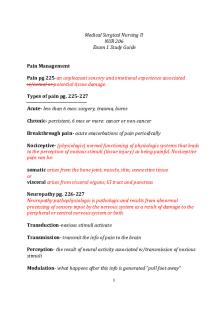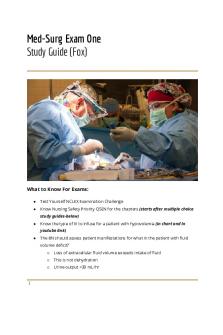Med Surg II - Exam 2 Study Guide PDF

| Title | Med Surg II - Exam 2 Study Guide |
|---|---|
| Course | Medical Surgical Nursing Ii |
| Institution | Cleveland State University |
| Pages | 57 |
| File Size | 1.6 MB |
| File Type | |
| Total Downloads | 79 |
| Total Views | 135 |
Summary
Exam 2 Study Guide...
Description
Exam 2 notes Respiratory
A patient with synchronous primary cancers of the larynx and floor of the mouth treated by laryngectomy, excision of the floor of the mouth, and skin grafting. Will be sitting up in high fowlers, will not be putting people flat Fracture of the nose o Displacement of the bone or cartilage can cause airway obstruction or cosmetic deformity because the nasal passage clean things out in the air that are potential sources of infection o Concerned about CSF leakage May indicate a skull fracture Leakage may not be clear because of the fracture, will have to test for glucose and paper test will determine There may be a halo of fluid and blood indicating the CSF o Simple fracture No blood or fluid If there is blood/CSF then its more serious fracture o Interventions Assessment Document a nasal problem Document nasal hx Crepitus Bruising Pain Closed reduction Snapping it back into place Rhinoplasty Immediate post operative o Splint o Moustache drip pad, change as needed o Monitor for drainage o Observe for edema and bleeding o Will take about 6 months to a year to heal o Check VS q4 o May order ice and quaze for swelling o Monitor for bleeding Watch for increased amount of swallowing o Might be some brusing- most likely for several weeks Education o Edema can last for weeks o Final results may take 6-12 months
o Position in a Semi-fowlers o Humidified air because the nasal packing in the nose o Move slowly o Check the gag reflex before eating o Drink 2500cc of fluid per day if not contraindicated o Will need to mouth breath o Will have packing in both of the nostrils o Splint needs to stay on to keep things into alignment Naso-septoplasty
Epistaxis o Nosebleed is a common problem o Cauterization of affected cappilaries may be needed Nose will be packed o Posterior nasal bleeding is an emergency Because it is too far back in the nose, can be hard to manage o Assess for respiratory distress, tolerance of packing or tubes o Humidification, O2, bedrest, antibiotics, pain medications (if needed) o Causes Trauma High BP (if diagnosed, need to know about the meds taking) Tumor Chronic cocaine use Leukemia Low humidity Picking the nose Nasal tracheal suctioning o Problem Can’t reach the area easily and can lose a lot of blood easily Cancer of the nose and sinuses o Tumors are rare, can be benign or malignant o Seen with exposure to dust from wood, textlies, leather, as well as flour, nickel, chromium mustard gas, radium (work place exposure) o Slow onset, manifestations resemble sinusitis Will continually be diagnoses with sinusitis Persistent drainage, bloody discharge and pain o Community care/preventions What should be taught to whom? People who are exposed to the things listed above o Sinusitis: Drainage
Bloody discharge Pain in the nose area If symptoms don’t go away need to address them Can scan the sinus and look up the nose o Local lymph enlargement often occurs on side with tumor mass is located o Surgical removal is main treatment May be combined with radiation also can be combined with chemo or even both o Post surgery usually body image issues Also airway, bleeding, wound care, trach care surgery dependent Facial Trauma o Priority action is airway assessment o And airway support o Could be difficult to intubate a patient with facial trauma o Manifestations Stridor Upper airway blocking Assess for distress SOB and dyspnea Anxiety and restlessness Hypoxia and hypercapnia High CO2 and low O2 Will show s/s of restlessness and anxiety Cyanosis, LOC- will not be the 1st thing you see Check the trauma, eye movement, and if the eye is being compromised Likely not able to intubate, will need airway support Eye movement will be a problem and teeth depending on what the issue is Bruising behind the mastoid, can indicate brain and skull trauma o Interventions Airway assessment is PRIORITY Anticipate need for emergency intubated because of the airway blockage Tracheotomy Cricothyroidotomy Fixed occlusion If had a major fracture of the face will need this It is the wiring of the jaw shut and wires all the way across Will need wire cutters at the bedside to reduce aspiration, emesis and chocking Will be wired shut about 6-10 weeks Will need to assess for nutrition.
Debridement If there is an infection Will take more time for swelling and inflammation to go down Will take 6 weeks or more to heal Diet Wired shut so will need a liquid diet o Soups o Milkshakes Body image o May be upset because jaw is wired shut Dr on consult ENT Nutiriton Resp (maybe) Dental Plastics (maybe Ophthalmologist (if there is eye damage or injury) Disorders of the Larynx o Vocal cord paralysis (aren’t working, one or both sides ) From trauma, injury or disease Could also be if intubated for a long period of time Cause can be temp or permanent o Vocal cord nodules and polyps Growths the don’t belong Likely 1 cord and not both Airway will remain open but voice will be affected Horse or weak voice If both cords, aspiration is a problem Want to watch for an obstruction of the airway o Laryngeal trauma Crushing or blow injury that can lead to a fracture Upper airway Obstruction o Interruption in airflow through the nose, mouth, pharynx or larynx o Life threatening emergency o Early recognition is essential in preventing further complications, including respiratory arrest o ANY NECK or FACIAL trauma can lead to an upper airway obstruction Will need to assess the airway 1st And be alert! Think about edema, swelling and neck surgeries
Interventions Asses the cause Will need an airway ET if they can have it Maintenance of a patent airway and ventilation Cricothyroidotomy Endotracheal intubation (nasotracheal or orotracheal) o If they can o If facial trauma, can not do this Tracheotomy Head and neck cancer o Usually squamous cell carcinoma and slow growing o Usually begins with mucosal that is chronically irritated, becoming tougher and thicker o Usually leukoplakia (white lesions) and erythroplakia lesions (red lesions) in the mouth Increased throat and mouth cancer If it is cancerous will have these Chart 29-1 and table 29-1 o Areas that can be affected Salivary Esophagus Neck Throat Lips Mouth Tongue How big the tumor is determines what they will or will not do o Physical assessment/clinical manifestations of cancer Lumps in the mouth, throat and neck Difficulty swallowing Color changes in the mouth or tongue Oral lesions or sores that do not heal in 2 weeks Persistent, unilateral ear pain Can indicate a tumor Usually slow growing Not always caught early Good cure rate if caught early Likely to be found when go to the dentist Persistent/ unexplained oral bleeding Numbness of the mouth, lips or face (cant explain why) o
Change in the fit of the dentures Burning sensation when drinking citrus or hot liquids Hoarseness or change in voice quality Persistent/ recurrent sore throat SOB Anorexia and weight loss o Interventions Radiation therapy Chemotherapy Cordectomy- removal of vocal cords Layngealectomy Esophagectomy Nodal neck dissection, removal of lymph nodes if they are suspected to be an issue Where they are and what type will depend on what interventions are done o Interdisciplinary Care Surgeon Speech Nutritionist RN Possibly Hematology Cancer doc ENT Plastics Home care Case management Laryngectomy Post operative care o 1st priority is airway maintenance and ventilation o Wound flap, reconstructive tissue care Wound flap: skin from the thigh, back or abd. Put it over the site. if they have this, will need to dopple for perfusion and patency will dopple q1 for 1st 24 hours will have mark where to listen, usually a blue stitch will monitor color, and temp do not want it to be a dark black or purple color. should have HOB up o Hemorrhage If carotic leak is suspected call CEMT, AMET, or RRT Slow oozing, so not apply pressure
o
o o
o
o o
Can make it rupture Is leaking a lot, apply pressure and try to save blood Wound breakdown Checking the site where the skin was taken from and make sure healing right Pain management Nutrition Likely a peg tube prior to surgery for supplementation Speech and language rehab Can use yanker suction to clean out mouth Complications Obstruction Bleeding Wound break down Tumor reoccurrence Nursing priorities Assist in swallowing exercises Retrain them if needed Prevent aspiration during swallowing How to swallow right with speech Chart 23-9 RN may need to supervise 1st oral feeding More likely will be speech May need to teach client/significant other how to suction and provide oral hygiene Manage wound care If skin flaps are used assuring adequate circulation Essential for tissue perfusion When home just assess Communication can be difficult Community based care Home care mamangament Teaching for self management Stoma care Communication Smoking cessation Tube feedings (if they have) Medication Psychosocial preperatin Preop is very imporatn Will need to explain everything
Educate on long recovery process Healthcare resources Nutiriton Speech PT/OT Need increased humidity No dust in the house, can cause infections During recovery: May have set backs Frustrations Discharge plan and safety Emergency ID and plan See chart 29-4 Self management prep Showering and bathing, shaving o No water right onto the stoma o No shaving whiskers Cover stoma when coughing Cover stoma when out Clean with mild soap and water Humidification Medic alert band No swimming
o
COPD o Includes Emphysema What happens? o Damage to the alveoli level o Alveoli don’t expand as they need to Cause: o Genetic o Exposure What do you see? o SOB What is the cause o Smoking (main cause) s/s o over time will have lower SpO2 o increased secretions
o increased CO2 o increased accessory muscle use o clubbing Chronic bronchitis Inflammation of the bronchi and bronchioles caused by chronic exposure to irritants, especially cigarette smoke Inflammation, vasodilation, congestion, mucosal edema, bronchospasm Affects only the airways, not alveoli o Can exchange gas but thick mucous makes it hard to get in O2 and CO2 out Production of large amounts of thick mucus Complications o What cn happen to the lungs? Decreased O2 and excess CO2 over time o What happens with cardiac Overwroked heart Can lead to pulmonary HTN Then can lead to right sided heart failure o Long term? O2 problem High risk for infection Resp failure over time (likely to die from) Orthopnea Laboratory assessment o ABG values for abnormal O2, ventilation, acid base status (CO2 retention) Respiratory acidosis o Sputum sample- infection? o CBC WBC Only COPD will have an increase because body will compensate by making more red blood cells o H/H Increases because body needs more O2 So makes more RBC o Serum electrolytes o Serum AAT o Chest x-ray o PFT (best way to measure lung function) Surgical management o Lung reduction surgery (picture ) o Rare and expensive, need a donor o operative procedure by median sternotomy or VATS
o o o
o
o
o
VATS- video assisted thoroscopic surgery Post operative care and close monitoring for compilations Not done often ($$) Purpose is to improve gas exchange Increase forced expiratory volume Decrease the total lung capacity Decrease residual volume Activity tolerance increase No need for O2 therapy Pre op Selected patients for this procedure Have ends stage emphysema Have minimal chronic broncitits Stable cardiac function Ambulatory Not vent dependent Free of pulmonary fibrosis, asthma or cancer Not a current smoker (at least 6 months) likely to not have this because of comorbitites especially cardiac operative deflate the lungs separately one side at time examine color and texture once they are deflated normal lung tissue darkens to purple and grey, will become more rubbery and dense hyperinflated areas do not deflate and remain pink will remove this tissue arms must be above head for this procedure will take about 4-6 hours Post operative care Monitor resp system for complication and airway Resp treatments Pulmonary hygiene Break up the secretions and keep things moving I/S Chest PT starting 1st day after surgery Loosen the secretions Incisions care
Monitor for infection, bleeding, drains, SpO2, lung sounds, nutotoon, increase calories and protein for healing Interstitial pulmonary diseases o Affects the alveoli, blood vessels and the surrounding support lung tissue o Restrictive disease; thickened lung tissue, reduced gas exchange, stiff lungs o Slow onset basically end up suffocating Prevents the gas expansion and reexpantion o Dyspnea most common manifestation Hard to move from bed to chair Sarcoidosis o Granulomatous disorder of unknown cause o Affects lungs most often o Autoimmune response- normally protective t-lymphocytes increase and damage the lung tissue o Corticosteroids are main therapy so slow down the symptoms o Inability to breath over time Idiopathic pulmonary fibrosis o Common restrictive lung disease o Highly lethal o Extensive fibrosis and scarring of the lung Fibrosis causes the lungs to not expand o Corticosteroids, other immunosuppressants mainstays of therapy But will likely die form this o High RBC because thinking more avaible to help with O2, but that isn’t the problems o Wont be able to get sentences and phrases out without difficulty breathing Lung transplants o Can do a single or double, will depend on the patient. o Criteria SL or BL differ slightly as well as disease process that the patient has Physiologically BL 60 or less or 65 of less SL Must have poor prognosis (18-24 months to live) Absolute compliance with meds and medical recommendations Scheduled times and can not miss a dose Tobacco free for “X” amount of time Usually 6 months Emotionally stable, no HIV, no cancer no infection Donor with health organs and free of infections No hx of chest surgery o Preop Psychological evaluation
Physical evaluation Labs Will have to have a boat load done Tissue matching Medication compliance They are on call- carry a pager Will get page when organ comes in Must drop everything and go to hospital Operation May need cardiopulmonary bypass Single or lobe transplant, patient doesn’t need bypass Bilateral- need bypass Use transverse thoracotomy (clamshell) incision Follows the rib cage underneath and across the body Diseased lung is removed New lung or lobes are places in the chest cavity and reattached to correct tubes 4-6 hours Post op Medications Antirejection meds Immunosuppressants No steroids right way, not till about 14 days after Fluid balance Monitor I/O carefully Resp status Monitor the vent chest tubes to reexpand lungs Major problems? Bleeding Infection Rejection Will go to ICU There for at least 48 hours With chest tubes and other lines Then to step down ICU Chest PT Chest percussion therapy Breaking things up Antirejection meds
o
o
Corticosteroids are avoided for the first 10-14 days Fluid volume Incision care o Home going Incision care (will take about 6 weeks to heal) Medication regime Ss to report to MD (teach) Follow up the labs Need to monitor immunosuppressants med levels o Usually blood related o Drainage o Fever o Labs follow ups Meds usually have therapeutic levels Avoid crowds (and sick people especially, high risk for infection) Avoid ill family members Wear mask in public Lung cancer o Leading cause of caner death worldwide o Poor long term survival dur to late stage diagnosis and metastasis o Bronchogenic carcinomas o Paraneoplastic syndromes o Staged to assess size/extent of disease o Etiology and genetic risk Can run in families, but more likely smokers or households with smoking o Not usually diagnosed till stage 3-4 o Health promotion and maintenance o Warning signals associated with lung cancer o Assessment HX Smoker Exposure Weight loss Pulmonary manifestations Nonpulmonary manifestations Psychosocial manifestations Diagnostic assessment X-ray Bronchoscopy
o
o o
o
o
o
**** consult DR if pt has New persistent cough or worsening existing chronic cough Blood in sputum Persistent bronchitis or repeated respiratory infections Chest pain Unexplained weight loss and or fatigue Can travel to the bone and the liver Surgical management Lobectomy- lobe of lung removed Pneumonectomy- whole 1 lung Segmentectomy- segment or portion of the lung, will include bronchus pulmonary artery and vein and other tissues Wedge resection- tiny little piece Will not have lung sounds where the parts were removed Operative 3 types of possible incisions Median sternotomy Posterolateral Anterolateral Cause use VATS Lung protion to be removed is isolated from the airway Closed off from the rest of the lung using a double stapling technique Tissue is sealed in a bag Try to prevent the leakage of cancer cells into the body. Do not want them to reseed and grow Chest tube placement 3 chambers Collects fluid draining from the patient Water seal prevents air from re-entering patient’s pleural space Suction control of the system Need to assess the drainage system Start at the patient work way down If draining more then 100 cc per hour, this is too much Nursing care after thoracotomy Pain management Local o Lidoderm patch around the site Regional o Nerve block IV
Opiods NSAIDS Toradol Will increase skin of bleeding so need to watch ebcaeuas it can help with inflammation Respiratory management o IS o Aerosols o Up and moving Pneumonectomy care o Care of the incision to make sure there is no infection Complication o Build up of fluid o Empyema o Ask dr if can lay on operative side or not o Will likely have a PCA Interventions for Palliation o O2 o drug therapy o radiation therapy decreasing tumor size o thoracentesis and pleurodesis pleurX catheter permanent catheter placed and drained every so often o Dyspnea management Take rests as needed o Pain management o Hospice care Patient can go home with and drain off at home (q 2-3 days) Will drain off if having pain Embolectomy Use a surgical or percutaneous methods to remove a pulmonary embolism Special catheters mechanically break up clots A local anesthetic or general anesthetic o Patient condition dependent Catheter is inserted into a main artery past beyond the embolus. The balloon is inflated, then the catheter is withdrawn with the balloon inflated thereby pulling the embolus out The artery is then flushed with a solution (usually heparin, unless allergic to) to deter the formation of the blood clots and the opening at the artery is sutured o o
o
Inferior vena cava filtrations Filter placed in vena cava Prevents emboli from getting to the lung Some filters can be removed, others meant to stay in Goes into the femoral vein to place it Procedure one under local anesthesia Clot catcher Need to check for pulses and bruits Will catch the clot and reabsorb it into the body Post OP o Inspect the site for bleeding o Monitor for s/s of infection o Monitor VS o Pulse in the legs used to place the filter** important because into the artery
Chest tubes Pneumothorax Air in pleural space o Can be ope...
Similar Free PDFs
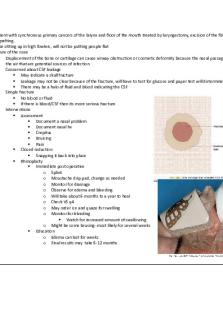
Med Surg II - Exam 2 Study Guide
- 57 Pages

Med Surg 2 Exam 3 Study Guide
- 22 Pages

Med surg exam 1 study guide
- 25 Pages
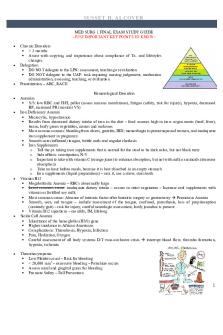
MED SURG 1 Final EXAM Study Guide
- 10 Pages

Med surg exam 3 study guide
- 68 Pages
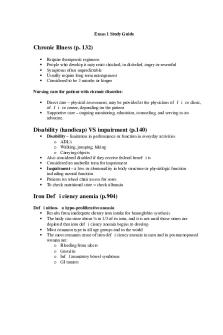
Exam 1 Study Guide - Med-Surg
- 26 Pages

Med Surg 2 Final Study Guide
- 25 Pages

Med Surg Study guide Notes
- 66 Pages

Med-Surg Test #2 Study Guide
- 10 Pages

Med Surg 2 Study Guide Answer Key
- 145 Pages
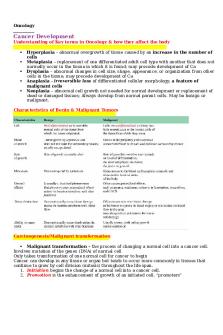
MED SURG 2 first study guide
- 20 Pages

MED SURG EXAM 3-2
- 54 Pages
Popular Institutions
- Tinajero National High School - Annex
- Politeknik Caltex Riau
- Yokohama City University
- SGT University
- University of Al-Qadisiyah
- Divine Word College of Vigan
- Techniek College Rotterdam
- Universidade de Santiago
- Universiti Teknologi MARA Cawangan Johor Kampus Pasir Gudang
- Poltekkes Kemenkes Yogyakarta
- Baguio City National High School
- Colegio san marcos
- preparatoria uno
- Centro de Bachillerato Tecnológico Industrial y de Servicios No. 107
- Dalian Maritime University
- Quang Trung Secondary School
- Colegio Tecnológico en Informática
- Corporación Regional de Educación Superior
- Grupo CEDVA
- Dar Al Uloom University
- Centro de Estudios Preuniversitarios de la Universidad Nacional de Ingeniería
- 上智大学
- Aakash International School, Nuna Majara
- San Felipe Neri Catholic School
- Kang Chiao International School - New Taipei City
- Misamis Occidental National High School
- Institución Educativa Escuela Normal Juan Ladrilleros
- Kolehiyo ng Pantukan
- Batanes State College
- Instituto Continental
- Sekolah Menengah Kejuruan Kesehatan Kaltara (Tarakan)
- Colegio de La Inmaculada Concepcion - Cebu
